May the Best Man Win!
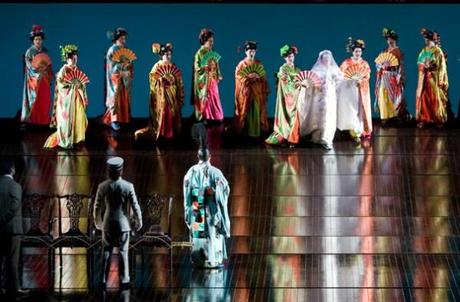
Madama Butterfly: Butterfly’s entrance from Act 1 (newyorkcitytheatre.com)
Yes, they were rivals. Giacomo Puccini and Richard Strauss — no relation to the “Waltz King” Johann Strauss, Senior or Junior — were undeniably rivals. Or so the accepted wisdom goes. But even as such, they were not openly antagonistic toward one another. They had other matters to be concerned about.
We know, with a good deal of certainty, that both labored under the strain of being the undisputed heirs to supposedly better men: for the Italian Puccini, his illustrious predecessor Verdi, and for the German-born Strauss, the burden of Wagner’s legacy. This intolerable state of affairs could hardly have made matters worse than they already were for enterprising musicians of that era — in particular, two such creative minds as those of Puccini and Strauss.
The question of whether there was a mutual admiration society going, what nowadays our ever-present pop-culture has flippantly defined as a “bromance,” is open to debate. Though separated by language, culture and country, the two composers were more alike than either cared to admit. Both gave the appearance of satisfaction with their lot (with Puccini the more challenged of the two, due to a pathological lack of self-esteem); both appreciated the finer things in life; and both were, materially speaking, quite prosperous — not “filthy rich” by modern interpretations of the term, but comfortably well off.
As a matter of expediency, having sufficient means at his disposal gave Puccini the ability to travel both for business and for pleasure, which meant these two compositional titans would occasionally meet. They enjoyed playing cards together, at least according to William Berger, author of Puccini Without Excuses, but “pointedly avoided discussing music theory,” a wise course indeed.
Puccini even found time to attend the May 1906 Austrian opening of Strauss’ one-act shocker Salome, with its composer presiding on the podium. Although the work perplexed him, Puccini, who was continually on the lookout for the new and the unusual, was transfixed by its erotic flavor and harmonic tone color. He had less to say about Strauss’ Die Frau ohne Schatten (“The Woman Without a Shadow”). When shown the massive opus’ score and pressed for an opinion, Puccini glanced at the pages and issued forth this modest appraisal: “It’s logarithms.”
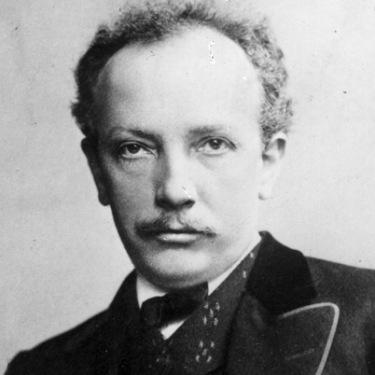
Composer Richard Strauss (biography.com)
On the other hand, Strauss was prone to remark (either positively or negatively) about anyone and everyone around him yet kept his personal views of Puccini to himself, with the exception of a few sarcastic asides. As Berger has indicated, “[Strauss] once explained to a journalist that he never said he disliked Puccini’s music. He simply needed to avoid it because” — and this is where the acerbic aspect comes in — “he couldn’t get the melodies out of his head and feared that he would write Puccinian Strauss.” How shamelessly insincere is that?
Nevertheless, we can surmise that each man learned a little something from the other — if not wholly, then in part. In Puccini’s case, one finds a curious-minded artist — by all reports, not necessarily of the highest intellectual order but exceptionally well-read — drawing upon the stimuli of some of the century’s most pioneering talents. Elements of late Verdi and the Russians Stravinsky and Mussorgsky, his pal Strauss, the Frenchman Debussy, and — oh yes — even Herr Wagner, had started to trickle into his oeuvre as early as Manon Lescaut, and as recently as La Bohème and Tosca. To these, we need only add the rudiments of Japanese folk music (Madama Butterfly), American minstrel tunes and the whole-tone scale (La Fanciulla del West), French Impressionism (Il Trittico), waltzes from Old Vienna (La Rondine), and finally Chinese-based songs (Turandot).
In short, if Puccini, with all his self-deprecating humor, heart-on-sleeve sentimentality and unrequited love for those same unforgettable female characters he created, wasn’t the most cosmopolitan of opera composers, we are hard-pressed to find a more widely popular one. With time, previously narrow-minded viewpoints regarding his rightful place in musicology would be refreshingly replaced by the expert commentaries of noted biographers Mosco Carner, Mary Jane Phillips-Matz, Julian Budden, Michele Girardi and the aforementioned Mr. Berger, all to a Puccini lover’s delight.
Because of their invaluable research into the composer’s life, music and art, it is fitting to note as well that Puccini, an all-around man of the theater and intrepid explorer ready and willing to expand his musical horizons, in spite of severe setbacks and personal misfortunes evidently got better at his craft as he aged. He died in Brussels on November 29, 1924, of heart failure after an operation for throat cancer.
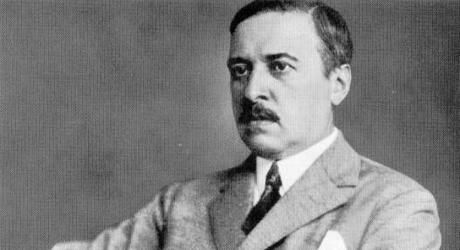
Poet Hugo von Hofmannsthal (jbeilharz.de)
In the matter of Strauss, most historians and musicologists would agree that even with the Italian’s passing, the German composer’s best days were behind him with the untimely demise, in 1929, of his primary librettist, Austrian playwright and poet Hugo von Hofmannsthal. Their four earlier collaborations, beginning with Elektra (1909), Der Rosenkavalier (1911), Ariadne auf Naxos (1912, revised 1916), and Die Frau ohne Schatten (1919), are considered the team’s worthiest efforts. These were followed a few years later by Die ägyptische Helena (1927) and Arabella (1933, produced posthumously), neither of which (in America, at any rate) had the staying power of the previous four.
One can ponder the possibilities of what “could have been” had Puccini, who was a month short of his 66th birthday at his passing, lived to Strauss’ ripe old age of 85. One can only imagine how much better and, well, let’s be honest: more “Puccinian Strauss,” the German’s output might have sounded had his Italian card-playing colleague continued to surprise us with newer and ever-more enchanting discoveries.
Butterfly Takes Wing
With the above in mind, we may look to Madama Butterfly as one of the truly great inspirations to have emerged from the Italian operatic firmament. Originally conceived as a three-act work, Puccini changed his mind incessantly, and drove his librettists to distraction, all throughout the creative process regarding the shape, size, scope and substance of his masterwork.
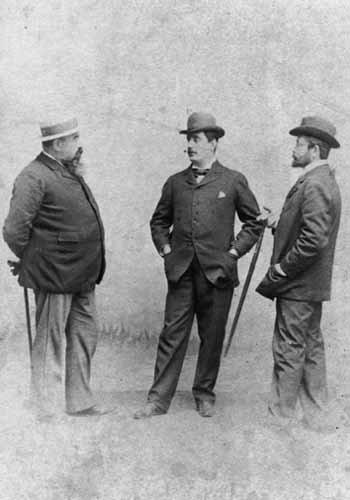
Giacomo Puccini (center), flanked by Giuseppe Giacosa (left) and Luigi Illica (right) (librari.beniculturali.it)
It became a two-act drama after the composer insisted to one of his collaborators, Luigi Illica, that an entire act intended to take place at the American Consulate be dropped. Upon hearing this outrage, the opera’s co-librettist, Giuseppe Giacosa, dashed off a missive to Puccini stating that disaster would no doubt strike the first performance should he continue along this ruinous path. Undeterred, Puccini stuck to his guns, even making his thoughts known to their publisher, Giulio Ricordi, that in his heart of hearts he knew categorically that he was right.
As it turned out, and as posterity has since shown, the opera’s world premiere on February 17, 1904, was a total fiasco, if not one of the biggest calamities in the history of La Scala, Milan. We need not delve into the specifics, however let it suffice that Puccini had severely miscalculated his audiences’ attention span with respect to the excruciatingly long second act (long by Italian standards that is).
Reverting to their original plan, Illica and Giacosa went about reworking the opera’s text in accordance with the now-thoroughly humbled composer’s wishes. At the same time, Puccini cut and pasted, as well as recycled, bits and pieces of his music from the rejected Consulate scene, some of which included a brief arioso for the tenor and a trio for mezzo-soprano, tenor and baritone.
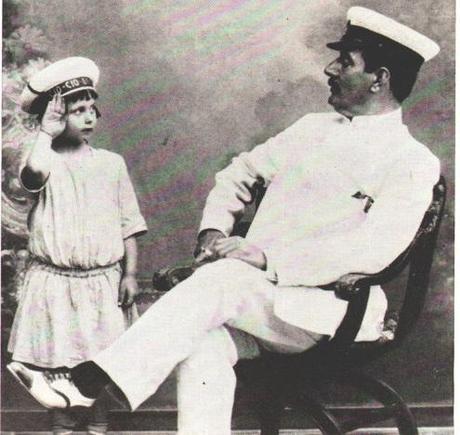
Puccini as Pinkerton with Bibi, his step-granddaughter (pinterest.com)
Three months later, on May 29 in nearby Brescia, the revised Madama Butterfly was given another shot at life — not exactly a rarity in opera — and met with smashing success. Several more productions later, specifically a fortuitous one at the Opéra-Comique, in Paris (under the management of Albert Carré), the composer was convinced that his Butterfly would fly once again and take wing as one of the world’s best-loved works.
It’s Showtime!
Continuing this winning trend, the Metropolitan Opera presented the late Anthony Minghella’s production of Madama Butterfly on Saturday, February 1, a radio broadcast. With its novel use of Bunraku puppetry (courtesy of Blind Summit Theatre), gorgeous costume designs (Han Feng), sets (Michael Levine) of polished mirrors above and below the stage, spot-on direction and choreography (Carolyn Choa, Minghella’s widow), this was a highly stylized retelling of the story that, in the current revival, is one of the company’s most praiseworthy efforts.
The Met’s cast, including debuting South African soprano Amanda Echalaz in the demanding title role (a.k.a. Cio-Cio-San), New Orleans native Bryan Hymel, who made such a splash last season in Les Troyens, as Lt. Pinkerton, Scott Hendricks as the American Consul Sharpless, Elizabeth DeShong as maidservant Suzuki, Scott Scully as marriage broker Goro, and baritone Alexey Lavrov as Prince Yamadori, were all new to their parts.
The opera was conducted by French maestro Philippe Auguin, which is only proper since the completely sliced and diced version of the opera we know so well made its crucial mark in France. Auguin dived head first into the opening fugato section. The French certainly have a way with this work —i.e., the innate exoticism and foreignness of it all. And Auguin was constantly alive to the score’s intricacies, one of Puccini’s justifiable gems. The music flowed easily and assuredly from one climax to the other, the warmth of the violins was especially telling, and the rapid-fire banter between the two tenors at the start was under his firm control. Never too bombastic or lax in his leadership, Auguin brought out nuances that are oftentimes lost within the Met’s vast expanse. That’s the advantage of listening at home on the radio!
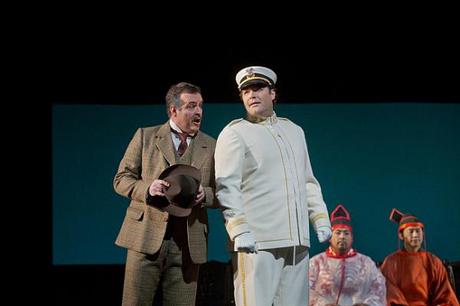
Sharpless (Scott Hendricks) & Pinkerton (Bryan Hymel) (minnesota.publicradio.org)
Tenor Bryan Hymel, who I praised to the rafters last year as Énée, portrayed a brash, frisky, lively Pinkerton. A breath of fresh air in this part, he offered excellent diction, a firm line, and easy and thrilling top notes in “Dovunque al mondo,” along with a caddish depiction of this most reprehensible of tenor leads. It’s almost a sin to say that Pinkerton has the most infectious lines of any of the male characters. Despite his betrayal of Butterfly, he’s the first voice we hear at the curtain’s rise. He’s onstage continuously and throughout the entirety of Act I. If he’s missing in action for Act II, Pinkerton all-but pops back for a brief solo (“Addio, fiorito asil”) and trio (previously noted). He even gets to deliver the opera’s last line: “Butterfly, Butterfly!”
Despite this impressive assumption, Hymel never quite approached the rascally heights that Beniamino Gigli achieved in the classic RCA Victor recording of the work with Toti dal Monte in the lead. As it was, Bryan acquitted himself admirably. I was never so glad to hear Pinkerton sung so convincingly and forthrightly, and happier still that the Met gave this honest-to-goodness primo tenore an opportunity to strut his stuff. Hymel’s worth his weight in gold, and I hope he keeps up the momentum. Now, if we could hear him in something completely different, perhaps Meyerbeer’s Robert le Diable (which he’s sung in Europe), Arnaud in Rossini’s Guillaume Tell, or even Henri in the original French-language version of Verdi’s I Vespri Siciliani, or Les Vêpres Siciliennes if you want to get technical. Hint, hint…
Scott Hendricks brought sympathy and understanding to Sharpless. He accompanied Hymel well in their first act duet (a wonderful showpiece too often treated as an aside), and blended nicely with him and Elizabeth DeShong (moving and firm-voiced) as Suzuki in their last act trio. Although Sharpless has no aria of his own — the lone solo that Puccini wrote for him was cut from Act II for fear it would hold up the action — it’s still a gratifying part. What remains is satisfying and rewarding, the perfect vehicle for an up-and-coming singer of Hendricks’ gifts.
In that same Act II, Sharpless attempts to read Pinkerton’s “Dear John” letter to Butterfly, to the strains of the humming chorus which echo the so-called “night vigil” that closes the act — the spot where Puccini initially inserted an intermezzo instead of lowering the curtain. It was this interval that so riled the La Scala public into action. Incidentally, Hendricks could have voiced his entreaties to Cio-Cio-San a shade more securely and with more feeling.
As Goro, tenor Scott Scully’s diction and phrasing left much to be desired. Vocally, he was merely adequate without being in any way outstanding. Sorry, Scotty! The other members of the cast, among them bass Paul Corona as the Imperial Commissioner, tenor Juhwan Lee as the Registrar, mezzo-soprano Maya Lahyani as Kate Pinkerton (a role substantially reduced from the original score), and the booming bass-baritone of Ryan Speedo Green as the fearsome Bonze, were all fine.
You’re Only as Good as Your Next Role
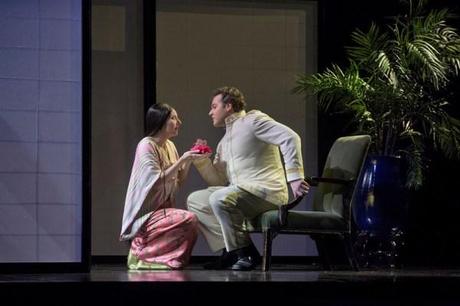
Cio-Cio-San (Amanda Echalaz) & Pinkerton (Bryan Hymel) (newyorkclassicalreview.com)
I’ve left the most difficult portion of my review for last. Whatever one might think of the character of Cio-Cio-San, the part itself is a marathon assignment of almost non-stop singing and acting. The best description we can give is of an emotional rollercoaster: the listener is taken on a ride through those three acts — vocally, psychologically, dramatically, lyrically, indeed in every way that’s possible in the theater. If this were a Wagnerian work of epic proportions, I’d say that Butterfly is Puccini’s Isolde and Brünnhilde, all rolled into one.
Puccini would have a deemed his little Japanese geisha the acid test for any soprano, lyric or otherwise. Did newcomer Amanda Echalaz pass the test? At her first appearance, Ms. Echalaz was a tentative sounding Cio-Cio-San in her entrance song, “Ancora un passo or via.” She did not take the alternate high note, which is fine since Puccini didn’t write it. Tradition has it, though, that the note is usually sung (a high D, if I’m not mistaken). Good luck with that!
More problematic for me was a realization that the steadfast nobility of the character, that unwavering quality that makes the best Butterfly interpreters stand out from the pack, was sorely lacking at this phase of the soprano’s career. The voice, while pleasant in timbre and fully-rounded in the middle, has yet to open up on top. She needs more exposure in the part to make the requisite impact.
Her “Un bel di,” one of Puccini’s loveliest and most heartbreaking numbers was strongly vocalized, but earned only polite applause. The aria comes early in the act, with more shattering revelations to come, so one can excuse Echalaz for the letdown. As most Cio-Cio-Sans are wont to do she excelled in the latter portions of Act II, especially her dialogues with Suzuki and her exchanges with the Consul Sharpless and Prince Yamadori where she correctly distinguished between the various aspects of the judge and misbehaving bridegroom.
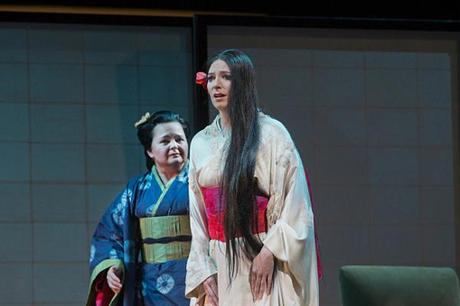
Suzuki (Elizabeth DeShong) & Butterfly (Amanda Echalaz) in Act 2 (minnesota.publicradio.org)
Oddly, at the point where she and Suzuki discover Pinkerton’s ship entering Nagasaki harbor, Ms. Echalaz chose that moment to introduce an annoying habit of lingering on the last word of the phrase “Ei torna e m’ama” (“He’s coming back and he loves me”), then slid down to the next note value in an inappropriate display of glissando. She should consider correcting this fault at the earliest. It was one of the few signs of sloppiness in a generally polished performance. Unfortunately, polished is the best one can say for her interpretation overall.
Another example would be the lines that come after the phrase “Che tua madre,” which should pierce the heart of audiences with its sorrow and pathos, as well as bring a tear to their eye. It did neither in Echalaz’s rendition. Now, I am certain the soprano’s bright sound can find a comfortable place in the Verdi repertoire, or as Mimì in La Bohème. But I’m not so sure it works in this environment. Her vowels all sounded alike to me: too open and undistinguished. Certainly, Echalaz has the goods and the potential. And it’s way too soon to tell if she’ll make a great Butterfly in the future, but the raw material is there. It just needs to be watered and nourished.
I’m also convinced that barring the other vocal aspects, Butterfly is a part that must be as well acted as it is sung. It’s a matter of putting the character into the voice, as well as having her in your bones. To do all this lyrically, and in song, with a hundred-piece orchestra in front of you, is the supreme challenge. Yet the role demands it, and Puccini insisted on it. As one of the most draining soprano parts in the Italian repertoire, it deserves singing and acting of the utmost concentration and commitment. Renata Scotto in her day, with less of a voice to work with, played the role for all it was worth.
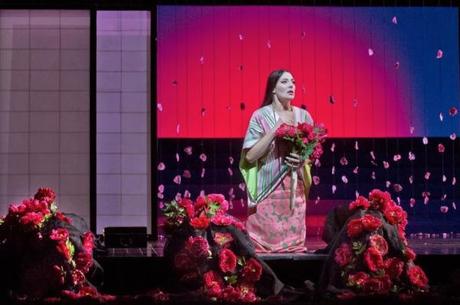
Amanda Echalaz: the Flower Duet (super-conductor.blogspot.com)
In summation, Echalaz gave it a good try, a noble effort when all is said and done. But going forward, she needs to step up her game, as they say in the sports world. I never once got the feeling that Echalaz was giving it her absolute all, although she was helped along by mezzo DeShong in the Flower Duet. Here, the voices formed a harmonious duo. It was also where I noticed, too, that Amanda lacks a true pianissimo, another deficit we hope she can work on.
Along with La Fanciulla del West and Il Trittico, Madama Butterfly is the composer’s most carefully constructed score, a one-of-a-kind experience, devastating in its intensity and in its portrayal of the title character who assumes the stature of a tragic heroine with her ritual suicide at the end. It’s the most sophisticated verismo score of any of its era. Butterfly was also Puccini’s favorite work, the only one of his creations he could listen to over and over again.
If we, too, are to listen to it over and over again, Madama Butterfly must be about more than just hitting the right notes. In her intermission interview, Echalaz claimed it was difficult to stay detached from the role since it is so emotionally fraught throughout. How true! But again, having a technique to fall back on — a rock-solid technique, at that — and keeping oneself focused, is the best way to survive this grueling assignment. Otherwise, what’s the point of performing it over and over again?
(End of Part One – To be continued)
Copyright © 2014 by Josmar F. Lopes

